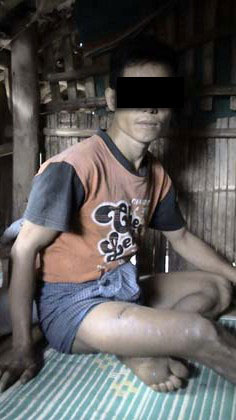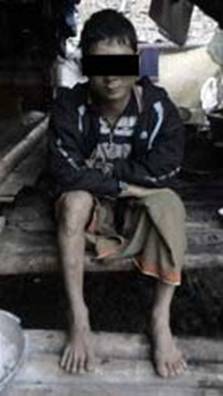|
|
Dooplaya District
Villagers in many areas of Dooplaya District are under constant threat of attack, forced labor, extortion, and other forms of physical abuse by the Burma Army and its proxy, the DKBA. Burma Army and DKBA camps are located in or close to many villages, and troops regularly enter these villages demanding food and property, forced labor, and abusing villagers. Troops are able to act with impunity and villagers have no method of recourse. The following reports highlight specific cases and are only a few of the many abuses that occur on a regular basis in Southern Karen State.
Burma Army kills three villagers and captures others in Kawkareik township
On 11 December, 2007, Burma Army troops from LIB 204 captured three villagers close to Mae Tler village in Kawkareik Township. The men captured were Maung Thaung Shwe, 33, Saw Wah Noe, 60, and Saw Maung Lah. When they were captured they were beaten badly, tied up and forced to go with the Burma Army troops. The men’s bodies were found three days later, two in a nearby cave and one in a mud pit. The troops from LIB 204 were under the command of Win Saw Oo. LIB 204 is under Div. 22.
 |
| Saw Tha Gay, after being captured, shot in the leg and escaping. |
On 10 December, 2007, troops from LIB 204 entered Poe Si Mu village in Kawkareik Township and captured Saw Tha Gay*, 35. After capturing him troops tied him up took him with them. Later that night, after slowly untying himself, Win Hone jumped up and ran away. The soldiers saw him running and about ten soldiers fired at him with machine guns. He was shot in the thigh, but managed to continue running. His leg has not yet completely healed.
*Note: The names of those who were captured and escaped have been changed
A day earlier, on 9 December, the same troops captured Aung Soe, 50, also from Poe Si Mu. His current whereabouts were not reported.
On 30 November DKBA troops entered KToe Hta village, capturing one villager named Saw Pa Thoo Thoo. They then beat him and tortured him before releasing him.
On 4 November DKBA troops captured six villagers from this area, beating each one of them severely before releasing them. The villagers are:
- Saw Pa Kaw
- Saw Toh Th’daw, 30
- Saw Mu Da, 33
- Saw Hser Tee, 48
- Saw Bper Kaw, 41
- Saw Nay Htoo, 42
On 6 December 2007, Burma Army IB 231 under MOC 12 attacked the area between Chaw Par and Kudone villages in Kawkareik Township. During the attack they captured two villagers; Saw K’paw Lah, 42, and Bo Naing, 65. They severely beat Saw K’paw Lah’s head and slapped Bo Naing multiple times before they were both released.
On 5 December, DKBA battalion 333 under Mo Kyo attacked the KNLA’s 18 Battalion between Kawser and Taw Oh Hta villages. Casualties have not been confirmed, but it was reported that Mo Kyo was injured in the right thigh during the attack.
Burma Army tortures villager in Kya Inn Township
 |
| Saw Lah Shee, after being captured and beaten by the Burma Army |
On 3 December Burma Army LIB 401 captured Saw Lah Shee from Thee Kweh village. The Burma Army tied him up and accused him of helping the Karen resistance. They then forced him to follow them for three days, during which time he was beaten severely. When the Burma Army column reached Lay Poe village, a nun was able to convince the SPDC troops that Saw Lah Shee was a villager, and he was released. His wounds have not yet healed.
Destruction of Property in Kawkareik Township
On 24 November 2007 DKBA troops from Battalions 333, 999, and 907 entered KToe Hta village and burned down the home of Saw Pa Toe. His house was worth at least 500,000 Kyats. The soldiers then killed a goat belonging to Naw Mu Poe, worth 25,000 Kyats, burned down a hut belonging to Naw La Bu Mo, worth 20,000 Kyats and shot cows belonging to Naw Mo Kee. The cows did not die, but Naw Mo Kee then had to buy 30,000 Kyats worth of medicine to care for her cows.
DKBA troops conducted similar actions on the same day in Thaw Paw Oo Kee village. They burned down a house belonging to Naw Ma Kin La, and also killed ten of her goats and one ox for a total of more than one million Kyats damage. In the same village troops burned down a hut belonging to Naw Ma Sa La, worth more than 20,000 Kyats, and another hut which belonged to Naw Pay Gay worth 70,000 Kyats. These soldiers then killed a pig belonging to Naw Ta Loe and an ox belonging to Saw Pa Mu Wa.
On 20 November SPDC LIB 355 stole Naw Ma Yi’s one chicken worth 3,000 Kyats in K’ Toe Hta village.
Karenni State
Forced Labor, Villagers Injured by SPDC Landmine
In early December, LIB 261 forced villagers from Daw Paw Kler and No Ko villages in northern Karenni State to repair fences and electric poles around their villages. On 12 December 2007, at 9:00 am, as the villagers were working, an SPDC landmine exploded, injuring two men and one woman. The reparations are to an electric line which carries power from the Burma Army’s Hydro-power station at Law Pita near Loi Kaw.
The SPDC has now made identification cards mandatory for villagers in the Pasaung area of southern Karenni State. Up to 40,000 people will be affected by this new order which requires each family to pay more than 35,000 Kyats for the registration and the cards. People in this area have very little disposable income and many will be unable to pay for this process. It has not yet been reported what will happen to villagers who are unable to purchase the cards.
Forced Relocation
December 20, 2007. Daw Kle Tey village in Sha Daw Township has now been ordered to return to a forced relocation site after being allowed to live for one year at the original location of their village. All 32 families, with a total of 185 people, have been ordered to move to the relocation site. The village’s Roman Catholic priest requested that the village be allowed to stay, however the Burma Army denied this request.
Other villages that have been forced to relocate close to Burma Army camps in this area are Daw Ta Naw and Daw Naw Klu, both of which must provide regular forced labor for the nearby camps. Daw Kle Tey villagers are worried that they will be forced to provide similar labor if they are moved to the relocation site.

